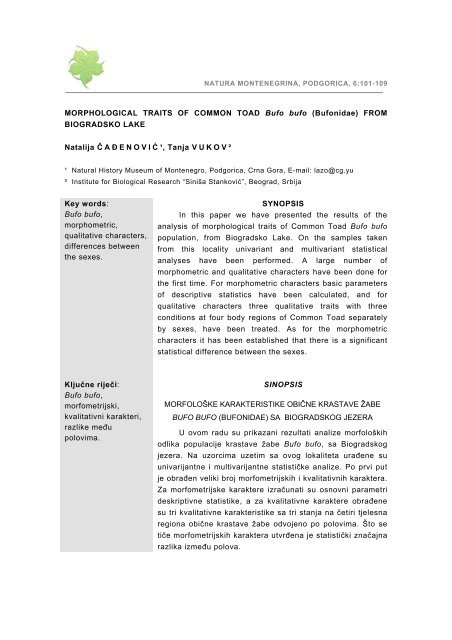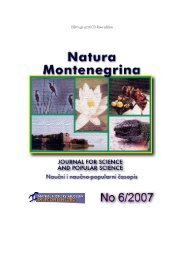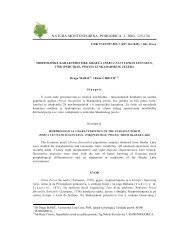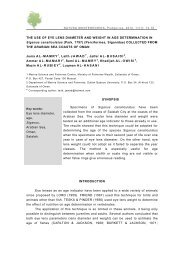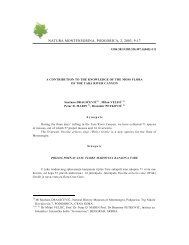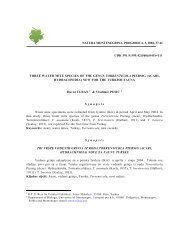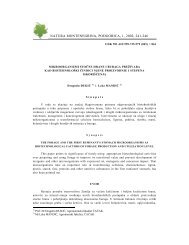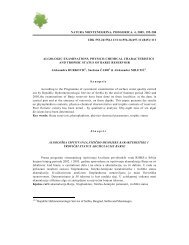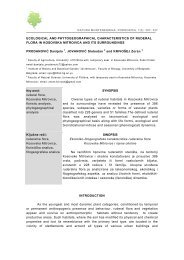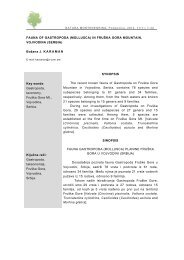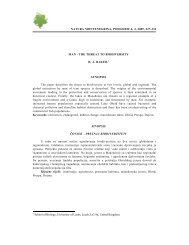MORPHOLOGICAL TRAITS OF COMMON TOAD Bufo bufo ...
MORPHOLOGICAL TRAITS OF COMMON TOAD Bufo bufo ...
MORPHOLOGICAL TRAITS OF COMMON TOAD Bufo bufo ...
You also want an ePaper? Increase the reach of your titles
YUMPU automatically turns print PDFs into web optimized ePapers that Google loves.
NATURA MONTENEGRINA, PODGORICA, 6:101-109<br />
<strong>MORPHOLOGICAL</strong> <strong>TRAITS</strong> <strong>OF</strong> <strong>COMMON</strong> <strong>TOAD</strong> <strong>Bufo</strong> <strong>bufo</strong> (<strong>Bufo</strong>nidae) FROM<br />
BIOGRADSKO LAKE<br />
Natalija Č A Đ ENOVIĆ ¹, Tanja V U K O V ²<br />
¹ Natural History Museum of Montenegro, Podgorica, Crna Gora, E-mail: lazo@cg.yu<br />
² Institute for Biological Research “Siniša Stanković”, Beograd, Srbija<br />
Key words:<br />
<strong>Bufo</strong> <strong>bufo</strong>,<br />
morphometric,<br />
qualitative characters,<br />
differences between<br />
the sexes.<br />
SYNOPSIS<br />
In this paper we have presented the results of the<br />
analysis of morphological traits of Common Toad <strong>Bufo</strong> <strong>bufo</strong><br />
population, from Biogradsko Lake. On the samples taken<br />
from this locality univariant and multivariant statistical<br />
analyses have been performed. A large number of<br />
morphometric and qualitative characters have been done for<br />
the first time. For morphometric characters basic parameters<br />
of descriptive statistics have been calculated, and for<br />
qualitative characters three qualitative traits with three<br />
conditions at four body regions of Common Toad separately<br />
by sexes, have been treated. As for the morphometric<br />
characters it has been established that there is a significant<br />
statistical difference between the sexes.<br />
Ključne riječi:<br />
<strong>Bufo</strong> <strong>bufo</strong>,<br />
morfometrijski,<br />
kvalitativni karakteri,<br />
razlike među<br />
polovima.<br />
SINOPSIS<br />
MORFOLOŠKE KARAKTERISTIKE OBIČNE KRASTAVE ŽABE<br />
BUFO BUFO (BUFONIDAE) SA BIOGRADSKOG JEZERA<br />
U ovom radu su prikazani rezultati analize morfoloških<br />
odlika populacije krastave žabe <strong>Bufo</strong> <strong>bufo</strong>, sa Biogradskog<br />
jezera. Na uzorcima uzetim sa ovog lokaliteta urađene su<br />
univarijantne i multivarijantne statističke analize. Po prvi put<br />
je obrađen veliki broj morfometrijskih i kvalitativnih karaktera.<br />
Za morfometrijske karaktere izračunati su osnovni parametri<br />
deskriptivne statistike, a za kvalitativne karaktere obrađene<br />
su tri kvalitativne karakteristike sa tri stanja na četiri tjelesna<br />
regiona obične krastave žabe odvojeno po polovima. Što se<br />
tiče morfometrijskih karaktera utvrđena je statistički značajna<br />
razlika između polova.
102<br />
Natura Montenegrina, 6/2007<br />
INTRODUCTION<br />
Common Toad has a large distribution and popultes mainly the entire palearctic<br />
area. It populates almost the entire Europe, with the exception of far north, Ireland,<br />
Corsika, Sardinia, Balear's Islands, Malta, Crete, as well as some smaller<br />
islands (B o r k i n and V e i t h , 1997). It also populates the northwestern Africa<br />
(P a s t e u r and B o n s , 1959). Although common at lower altitudes, it may also be<br />
found also on altitudes exceedeing 2500 m and on Iberian Peninsula (A n g e l , 1946;<br />
B o r k i n and V e i t h , 1997). In Montenegro it is mainly widely distributed. Owing to<br />
wide distribution, climatic conditions in various parts of areal of distribution are very<br />
different. Thus, in northern part of the areal the winters are long, cold and humid, so<br />
that the period favorable for growth is rather short (J o h a n n e s s e n , 1970). On<br />
higher altitudes the conditions are even more extreme. On the other hand, southern<br />
populations of this species are exposed to much more favorable conditions of outer<br />
environment; therefore the period favorable for growth is much longer.<br />
Species <strong>Bufo</strong> <strong>bufo</strong> is a polytypic one. From the scope of this species a taxon<br />
from the Far East has been separated on the level of species <strong>Bufo</strong> gargarizans<br />
(A n a n j e v a et al. 1998, K u z m i n 1999a, 1999b), and the character of polytype is<br />
determined to it in addition to nominotype subspecies three other ones B. b.<br />
grediscola, B. b. verrucosissimus, B. b. spinosus. If we recognize the fact that<br />
Caucasus Toad (<strong>Bufo</strong> verrucosissimus) is a separate species (e.g. O r l o v a &<br />
T u n i y e v 1989, A n a n j e v a et al. 1998), than the taxonomic differentiation in scope<br />
of Common Toad is even more limited. Nominotype subspecies is the most widely<br />
distributed (Northern and Southern Europe). The two first subspecies have a limited<br />
geographical area (mountains Gredos and Caucasus), nominotype subspecies is the<br />
most widely distributed (Northern and Central Europe), whereas the areal of<br />
subspecies B. b. spinosus is limited to the region of Mediterranean (northwestern<br />
parts of Africa, southeast Europe, southern Switzerland, Italy as well as the southern<br />
parts of France and Spain).<br />
MATERIAL AND METHODS<br />
A total of 41 specimens has been analyzed, 26 males and 15 females. The<br />
largest part of the material has been collected in mating period. The material has<br />
mainly been manually collected and meredov (a net with a handle) has also been<br />
used.<br />
The samples belong to herpetological collection of the Natural History Museum<br />
of Montenegro; they are kept in 70 % alcohole.<br />
Morphometric analysis has been done on 21 traits which determine size and<br />
form of body and head of tailless amphibians. Measured traits are: L – longthe of body
103<br />
Čađenović & Vukov: <strong>MORPHOLOGICAL</strong> <strong>TRAITS</strong> <strong>OF</strong> <strong>COMMON</strong> <strong>TOAD</strong> BUFO BUFO . . .<br />
from the top of head to the opening of the cloaca; Lpa – length of front exstremity; F –<br />
length of femur measured fromxthe opening of cloaca to knee joint; T – lengthj of<br />
tibiofibula from knee joint to tibiotarsal joint; P – distance from tibiotarsal joint to the<br />
tip of the longest finger (IV); n – length of metatarsus from the internal metatarsal<br />
ridgelet to the tip of the longest finger (IV); DpPa – length of the first finger off front<br />
exstremity; DpPp – length of the first finger of back extremity; Cint – the biggest<br />
length of the internal metatarsal ridgelet; Lc – length of head from the top of head to<br />
jaw joint; Ltc – width of head measured between the jaw joints; Spp – betweeneyes<br />
space between the internal edges of eye lids; Lc – lengh of head from the top of head<br />
to jaw joint; Ltc – width of head measured between jaw joints; Spp – betweeneyes<br />
space between the internal edges of eye lids; Spi – distance betwnn the outer nasal<br />
openings; Spcr – distance between front angles of eye openings; Lo – the largest<br />
length of eyeball; Ltp – the largest width of upper eye lid; Dro – distance from the top<br />
of head to the eye edge; Dno- distance of nasal opening from eye; Lh - length of<br />
cutaneous folds on heels; Lg - length of partoid salivary glands; Wg - width of<br />
salivary glands and weight.<br />
Three qualitative traits (Table 1) with three conditions on four body regions of<br />
toad: head part - dorsal side, dorsal part-dorsal side, head part -ventral side,<br />
abdominal part-ventral side.<br />
The conditions of qualitative traits have been coded in the following manner:<br />
Dorsal side – head part:<br />
1a - round warts, 1b - oval warts, 1c – kidneylike warts; 2a – very protuberant<br />
warts, 2b – protuberant warts, 2c – drawn in warts; 3a – very marked thornlike ends of<br />
warts; 3b – medium marked thornlike ends of warts; 3c – weakly marked thornlike<br />
ends of warts;<br />
Dorsal side - dorsal part:<br />
4a - round warts, 4b - oval warts, 4c - kidneylike warts; 5a – very protuberant<br />
warts, 5b – protuberant warts, 5c – drawn in warts; 6a – very marked thornlike ends of<br />
warts; 6b – medium marked thornlike ends of warts; 6c – weakly marked thornlike<br />
ends of warts;<br />
Ventral side – head part:<br />
7a - round warts, 7b - oval warts, 7c - kidneylike warts; 8a – very protuberant<br />
warts, 8b – protuberant warts, 8c – drawn in warts; 9a – very marked thornlike ends of<br />
warts; 9b – medium marked thornlike ends of warts; 9c – weakly marked thornlike<br />
ends of warts;
104<br />
Natura Montenegrina, 6/2007<br />
Ventral side – abdominal part:<br />
10a - round warts, 10b - oval warts, 10c - kidneylike warts; 11a – very<br />
protuberant warts, 11b – protuberant warts, 11c – drawn in warts; 12a – very marked<br />
thornlike ends of warts; 12b – medium marked thornlike ends of warts; 12c – weakly<br />
marked thornlike ends of warts;<br />
Trait<br />
Warts shape<br />
Condition<br />
a) round<br />
b) oval<br />
c) reniform<br />
a)very convex<br />
Warts convexity<br />
b) convex<br />
c) inverted<br />
Prominence of thornlike<br />
warts endings<br />
a)very prominent<br />
b)averagely prominent<br />
c)weakly prominent<br />
Table 1. Analysed qualitatie traits in <strong>Bufo</strong> <strong>bufo</strong><br />
Statistical Analysis<br />
Programme package STATISTICA (version 5.0) has been used for statistical<br />
analysis of data. For morphometric characters basic parameters of descriptive<br />
statistics have been separately calculated by genders: medium value ( x ), error of<br />
medium value (SE), standard deviation (SD), minimal (min) and maximal (max) values<br />
traits as well as coeficient of variation (CV). Analysis of sexual dimorphism has been<br />
performed on basic data (untransformed measures for every property), as well as on<br />
standardized residuals on eight traits (L, Lpa, F, T, P, n, Lc, Ltc). Regression of every<br />
property on body length (L) and use of standardized residuals from such a regression<br />
provides for the elimination of the impact of body size. Comparison of differences<br />
between the genders on basic data and on standardised residuals has been performed<br />
by the use of Tukey Test for the samples of uneven size.<br />
For the establishment of the significance of differences in respect of<br />
morphometric characters between the genders analysis of variance (ANOVA) has<br />
been used.<br />
Absolute and relative frequences (%) of the conditions of qualitative traits have<br />
been established. Qualitative traits have been analysed also through the<br />
corresponding analyses.
105<br />
Čađenović & Vukov: <strong>MORPHOLOGICAL</strong> <strong>TRAITS</strong> <strong>OF</strong> <strong>COMMON</strong> <strong>TOAD</strong> BUFO BUFO . . .<br />
RESULTS AND DISCUSSION<br />
Morphometric Characters<br />
Former data on values of morphometric characters of the species <strong>Bufo</strong> <strong>bufo</strong> are<br />
rather insufficient, or, some of them have been given only descriptively. That is why<br />
we have presented here the average values for a large number of characters that<br />
have not been previously analyzed and data about that do not exist in the literature.<br />
Basic parameters of morphometric characters descriptive statistics have been<br />
presented separately by sexes in the table 2. The smallest male of the sample of the<br />
population from Biogradsko Lake is 64.28, and the largest one 82.54 mm. The<br />
smallest female is 90.94 mm, and the largest 109.94 mm. Obtained values of body<br />
size of common toad from Biogradsko Lake are within the limits of the so far recorded<br />
values from other parts of areal of the species. (R a d o v a n o v i ć , 1951; A r n o l d and<br />
B u r t o n , 1978; Đ urović et al, 1979 etc).<br />
Sexual dimorphism has been analyzed in scope of population (localities) by<br />
application of Tukey test for samples of unequal size (“Unequal N HSD Tukey” test).<br />
This test has shown an expressed sexual dimorphism, where the females have higher<br />
average values of analyzed traits (Table 2). On basis of calculated parameters of<br />
descriptive statistics, separately by sexes and on basis of compared differences<br />
between the sexes, it has been established that the females have statistically higher<br />
values of all the characters, especially when the word is about L – body length, Lpa –<br />
length of front extremity, Lc – head length, Ltc – head width, Lg – length of salivary<br />
glands, weigth.<br />
With the population of Biogradsko Lake a great number of traits that have been<br />
demonstrating sexual dimorphism by the analysis of basic data where the size has<br />
been included, indicate the absence of sexual dimorphism for the largest number of<br />
characters when body size is excluded. The charactereistics which demonstrate the<br />
presence of sexual dimorphism also after the eliminating body size are T- length of<br />
tibiofibula and F – length of femur.<br />
Females are bigger than males in a large number of amphibian species<br />
(S h i n e , 1979; M i a u d et al., 1999; K h o n s u e et al.., 2001a, 2002b; M o n n e t and<br />
C h e r r y , 2002). That has been especially expressed with tailless amphibians in<br />
which females are bigger than males with 90% of species (S h i n e , 1979). This has<br />
also been established in this paper for studied population from Biogradsko Lake, as<br />
well as for the populations of the remaining part of the areal of distribution of this<br />
species (G i t t i n s et al., 1980; H e m e l a a r , 1988). The most common explanation of<br />
sexual dimorphism in body size is the advantge the females have in respect of eggs<br />
production (H a l l i d a y and V e r r e l l , 1986; C v e t k o v i ć et al., 2003). Namely,<br />
there is a positive correlation in many groups between body length and fecundity<br />
(C u m m i n s , 1986; B e r v e n , 1988; S i n s c h , 1998; G i b b o n s and M c C a r t h y ,<br />
1986). Assumption is that the selection, owing to a pointed correlation of body length
106<br />
Natura Montenegrina, 6/2007<br />
Males Females sexual dimorphism<br />
Unequal N HSD (Tukey)<br />
Trait N Means SD SE Min Max N Means SD SE Min Max basic data/standard results<br />
L 26 73.71 4.1447 0.8128 64.28 82.54 15 100.64 5.0865 1.3133 90.94 109.94 ***<br />
Lpa 26 54.62 3.6473 0.7153 46.68 63.17 15 71.64 3.7562 0.9699 62.23 77.60 ***/ns<br />
F 26 32.53 3.1809 0.6238 25.32 38.86 15 40.67 4.9746 1.2844 31.98 46.95 ***/***<br />
T 26 24.10 2.0556 0.4031 20.52 27.25 15 28.82 2.4023 0.6203 25.55 34.46 ***/**<br />
P 26 36.65 4.2990 0.8431 27.03 42.91 15 42.98 2.8349 0.7320 37.06 47.03 **/ns<br />
n 26 51.90 4.6742 0.9167 43.30 60.54 15 62.52 4.8611 1.2551 56.26 72.83 ***/ns<br />
n-P 26 15.25 4.0443 0.7931 7.26 22.45 15 19.54 4.4970 1.1611 12.24 27.70 **<br />
DpPa 26 6.58 0.7584 0.1487 5.10 7.99 15 10.44 1.5234 0.3933 7.48 13.45 ***<br />
DpPp 26 6.74 0.8867 0.1739 5.29 8.63 15 8.46 1.2908 0.3333 5.85 10.79 ***<br />
Cint 26 4.53 0.5892 0.1155 3.37 5.56 15 6.34 0.9030 0.2331 4.51 7.74 ***<br />
Lc 26 17.50 1.1857 0.2325 14.28 19.46 15 24.69 1.6894 0.4362 22.04 27.83 ***/ns<br />
Ltc 26 22.41 1.5435 0.3027 19.67 24.73 15 31.19 2.0888 0.5393 28.09 36.37 ***/ns<br />
Spp 26 8.75 0.9524 0.1868 6.72 10.92 15 12.55 1.6316 0.4213 9.75 15.07 ***<br />
Spi 26 4.03 0.5097 0.1000 2.85 4.92 15 5.32 0.6099 0.1575 4.39 6.47 ***<br />
Spcr 26 7.49 0.5751 0.1128 6.28 8.62 15 11.82 0.9789 0.2528 10.28 14.21 ***<br />
Lo 26 6.25 0.6112 0.1199 4.95 7.43 15 9.28 0.7010 0.1810 7.61 10.27 ***<br />
Ltp 26 5.88 0.6321 0.1240 4.32 6.71 15 7.80 0.8845 0.2284 5.72 9.61 ***<br />
Dro 26 7.54 0.5957 0.1168 6.27 8.75 15 10.72 0.8648 0.2233 9.42 12.33 ***<br />
Dno 26 3.22 0.3864 0.0758 2.59 4.08 15 4.49 0.5739 0.1482 3.54 5.41 ***<br />
Lh 26 3.56 0.5723 0.1122 2.65 4.77 15 5.09 0.3795 0.0980 4.49 5.81 ***<br />
Lg 26 14.86 1.7528 0.3438 11.78 18.10 15 20.77 2.2236 0.5741 17.04 24.34 ***<br />
Wg 26 5.80 0.7387 0.1449 4.53 7.50 15 8.20 1.0614 0.2741 6.48 10.06 ***<br />
Weight 26 44.50 6.4576 1.2664 33.00 56.00 15 141.07 31.1367 8.0395 97.00 230.00 ***<br />
Table 2. Basic parameters of descriptive statistics of males and females of Biogradsko Lake and Tukey (HSD) test with gender factor
107<br />
Čađenović & Vukov: <strong>MORPHOLOGICAL</strong> <strong>TRAITS</strong> <strong>OF</strong> <strong>COMMON</strong> <strong>TOAD</strong> BUFO BUFO . . .<br />
and fecundiy, favorises several values for body length of females. Greater eggs<br />
production on the other hand is explained by larger internal space for their storage,<br />
which larger females have (A n d e r s o n , 1994).<br />
The direction and magnitude of dimorphism in body length depend of various<br />
selective pressures the specimens of male and female sex are exposed to. D a r w i n<br />
(1871) assumed that sexual selection (though the competition among the specimens<br />
of the same sex or through an active selection of partner), may lead to sexual<br />
dimorphism. For instance, in species with pointed struggles among the males, males<br />
are frequently bigger than females.<br />
However, it is important to underline that common toad is one of rare secies in<br />
which males are a smaller sex, although there are struggles for females among them<br />
(H a l l i d a y and V e r r e l l , 1986; A r a k , 1988).<br />
Qualitative Analysis<br />
By a comparison of rerlative frequency of condition of monitored qualitative traits<br />
it has been noted that the same conditions, as a rule, have the greatest frequency<br />
both in the sample of males and in the sample of females (Tabele 3). The exception is<br />
the convexity of of warts in head region (in males the largest relative frequency have<br />
the warts which are indented, and with females warts are very protuberant) and the<br />
appearance of thornlike endings of ventral side of head region (most frequently weakly<br />
expressed in males and averagely expressed in females). The table of relative<br />
frequency of the conditions indicates that with females the variability of condition is<br />
higher than with males.<br />
By a correspondant analysis we have monitored the impact of qualitative traits<br />
on ordination of specimens of both sexes. The first corresponding axis has separated<br />
24.69% of variability, and the other one 17.03%. There is no clear sex separation<br />
(Figure 1). The sample of males indicates an uniformity in respect of monitored traits.<br />
Only one male has been separated during the second coresponding axis from the<br />
„main cloud” of male specimens on basis of two traits (11b and 12b) (Figure 2). One<br />
may observe a higher variability in scope of the sample of females. Traits 1c, 4b and<br />
5a separate two females along the first correspoding axis from other females, where it<br />
should be mentioned that these two traits as well as the traits 2a, 3b and 6b influence<br />
separating of females from males (Figures 1 and 2).<br />
The significance of this paper is in presenting for the first time the analysis of a<br />
larger number of morphometric and qualitative characters of population of the species<br />
<strong>Bufo</strong> <strong>bufo</strong> from Biogradsko Lake. These data make the grounds for further<br />
investigations of the populations of the species <strong>Bufo</strong> <strong>bufo</strong> both from Biogradsko Lake<br />
and the populations of this species from the territory of entire ontenegro.
108<br />
Natura Montenegrina, 6/2007<br />
LITERATURE<br />
ANANJEVA, N., BORKIN, L., DAREVSKIJ, I. & ORLOV, N. 1998: Zemnovodnie i<br />
presmikajuščiesja. - Enciklopedija prirodi Rosii. ABF, Moskva, pp. 574.<br />
ARNOLD, E.N., BURTON, J.A. 1978: A Field Guide to the Reptiles and Amphibians of<br />
Britain and Europe. – Collins, London<br />
ARAK, A. 1988: Sexual Dimorphism in Body Size: A Model and a Test. - Evolution 42:<br />
820-825.<br />
ANDERSON, S. 1994: Sexual Selection. - Princeton University Press, Princeton, New<br />
Jersey.<br />
BERVEN, K.A. 1988: Factors Affecting Variation in Reproductive Traits within a<br />
Population of Wood Frogs Rana sylvatica. - Copeia, 1988: 605-615.<br />
BORKIN, L.J., VEITH, M.1997: <strong>Bufo</strong> <strong>bufo</strong> (Linnaeus, 1758). In: GASC, J. P., GABELA,<br />
A., CRNOBRNJA-ISAILOVIĆ, J., DOLMEN, D.,GROSSENBACHER, K.,<br />
HAFFNER, P., LESCURE, J., MARTENS, H., MARTINEZ RICA, J.P., MAURIN,<br />
J., OLIVIERA, M.E., S<strong>OF</strong>IANIDOU, T.S., VEITH, M., ZUIDEREWIJK, A. (eds),<br />
1997. Atlas of Amphibians and Reptiles in Europe. Pp. 118-119. Societas<br />
Europaea Herpetologica & Muséum National d'Historie Naturelle (IEGB/SPN),<br />
Paris.<br />
CVETKOVIĆ, D., ALEKSIĆ, I., CRNOBRNJA – ISAILOVIĆ, J. 2003: Reproductive<br />
Traits in Common Toad <strong>Bufo</strong> <strong>bufo</strong> from the Vicinity of Belgrade. - Archives of<br />
Biological Sciences, Belgrade 55: 25P-26P.<br />
CUMMINS, C.P. 1986: Temporal and Spatial Variation in Egg size and Fecundity in<br />
Rana temporaria. - Journal of Animal Ecology 55: 303 – 316.<br />
DARWIN, C. 1871: The Descent of Man and Selection in Relation to Sex. – Murray,<br />
London.<br />
ĐUROVIĆ, E., VUKOVIĆ, T., POCRNJIĆ, Z. 1979: Vodozemci Bosne i Hercegovine. -<br />
Zemaljski muzej BiH, Sarajevo.<br />
GITTINS, S.P., PARKER, A.G., SLATER, F.M. 1980: Population Traits of the Common<br />
Toad (<strong>Bufo</strong> <strong>bufo</strong>) Visiting a Breeding Site in mid- Wales. - Journal of Animal<br />
Ecology, 49: 161-173.<br />
HALLIDAY, T.R., VERRELL, P.A. 1986: Sexual Selection and Body Size in<br />
Amphibians. - Herpetological Journal, 1: 86 – 92.<br />
HEMELAAR, A.S.M. 1988: Age, Growth and other Population Traits of <strong>Bufo</strong> <strong>bufo</strong> from<br />
Different Latitudes and Altitudes. - Journal of Herpetology, 22: 369-388.<br />
JOHANNESSEN, T.W. 1970: The Climate of Scandinavia. In: C. C. Wallen (ed), World<br />
KUZMIN, S.L. 1999a. Zemnovodnie bivšego SSSR. Tovariščestvo naučnih izdanij<br />
KMK, Moskva.<br />
KUZMIN, S.L. 1999b: The Amphibians of the former Soviet Union. Vol. I. - Pensoft,<br />
Sofia/Moscow.
109<br />
Čađenović & Vukov: <strong>MORPHOLOGICAL</strong> <strong>TRAITS</strong> <strong>OF</strong> <strong>COMMON</strong> <strong>TOAD</strong> BUFO BUFO . . .<br />
MIAUD, C., GUYETANT, R., ELMBERG, J. 1999: Variations in Life-history Traits in the<br />
Common Frog Rana temporaria (Amphibia: Anura): a Literature Review and New<br />
Data from the French Alps. - Journal of Zoology, 249: 61-73.<br />
MONNET, J. M., CHERRY, M. 2002: Sexual Size Dimorphism in Anurans. -<br />
Proceedings of the Royal Society of London, Series B-Biological Sciences 269:<br />
2301 – 2307.<br />
ORLOVA, V.F. & TUNIYEV, B.S. 1989: On the Taxonomy of the Caucasian Common<br />
Toads Belonging to the Group <strong>Bufo</strong> <strong>bufo</strong> verrucosissimus (Pallas) (Amphibia,<br />
Anura, <strong>Bufo</strong>nidae). - Biol. MOIP, Otd. biol., 94 (3): 13-24.<br />
PASTEUR, G. & BONS, J. (1959): Les Batraciens du Maroc. - Travaux de l'Institut<br />
Scientifique Cherifien, Serie Zoologique No 17, pp. 240. Rabat.<br />
RADOVANOVIĆ, M. 1951. Vodozemci i gmizavci naše zemlje. - Naučna knjiga,<br />
Beograd.<br />
SINSCH, U. 1998. Biologie und Okologie der Kreuzkrote (<strong>Bufo</strong> calamita). - Laurenti,<br />
Bochum.<br />
SHINE, R. 1979. Sexual Selection and Sexual Dimorphism in the Amphibia. – Copeia,<br />
2: 297 – 306.<br />
Received: 20.10.2007.
110<br />
Natura Montenegrina, 6/2007


